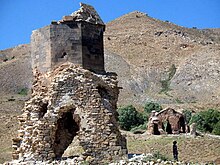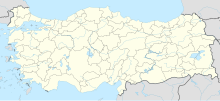Holy Apostles Monastery (Muş)
Coordinates: 38 ° 41 ′ 44.8 ″ N , 41 ° 31 ′ 10.3 ″ E
The Holy Apostles Monastery ( Armenian Սուրբ Առաքելոց վանք Surb Arakelots vank ) was a 6th century Armenian apostolic monastery in the province of Taron in historic Armenia , 5 km southeast of the city of Mus (now in the Eastern Anatolia region of Turkey ) . The monastery was destroyed by the Turkish army after the Armenian population of Muş was massacred during the Armenian Genocide in 1915.
history
The Arak'elots Monastery was founded in the 4th century by Gregory the Illuminator to house the relics he had received in Rome . These apostle relics - including the left arms of Saint Peter and Saint Paul and the right arm of the Apostle Andrew - contributed to the naming of the monastery.
Looting and theft of art left only building remains from the 10th century. During the re-established rule of the Mamikonians in the post-Byzantine period, the monastery became the most important cultural and religious center of Taron.
The history of the monastery after the Mamikonean rule is marked by Muslim raids, massacres, brief periods of abandonment, followed by a revival of the monastery community. Under the Ottoman rule, a certain stability returned and the prosperity of the monastery initially grew, but declined with the Ottoman-Safavid wars in the 17th century. In the 1660s, an earthquake destroyed most of the buildings. After the massacres of the Armenians under Sultan Abdülhamid II in the 1890s, the congregation was reduced to a prior and two to three monks. In 1901 a victorious Armenian battle for the monastery took place here. Thanks to the constant presence of the relics in the monastery, it remained an important place of pilgrimage until the First World War . In the course of events around 1915, the monastery was attacked and the last prior, Yovhannes Vardapet Muratian, was killed.
architecture
The monastery, located at an altitude of 1750 meters, consisted of the main church of St. Apostles, an almost square cross-dome building with a semicircular apse and rectangular side rooms in all four corners. In the west, a shamatun from 1555, which has now been destroyed, was built, the roof of which was supported by four square central pillars. To the south of the main church bordered the chapel of St. Stephen, dated 1663. The church of St. Thaddäus 300 meters east was a single-nave room with a central dome.
Possessions and graves
Many Armenian manuscripts , including the Homiliarium (Ms. 7729, known as the Muş-Homiliarium , the largest manuscript in Matenadaran ) belonged to the Arakelots Monastery.
The historian Movses Khorenatsi and the famous philosopher David Anhaght were buried near the Holy Apostles Monastery.
gallery
See also
- Surb Karapet , Anabaptist monastery northwest of Mus
- Yeghrduti Vank , Johannes monastery west of Mus
Web links
- Holy Apostles Monastery at VirtualAni.org
Individual evidence
- ↑ Richard G. Hovannisian (dir.), Armenian Baghesh / Bitlis and Taron / Mush, Mazda Publishers, Costa Mesa, 2001 ( ISBN 978-1568591360 ), p. 120
- ^ Patrick Donabédian, Jean-Michel Thierry: Armenian art . Herder, Freiburg 1988, p. 566f
- ↑ Armenian Miniatures, E. Korkhmazian, I. Drampian, Aurora, 1984, p 44
- ↑ Journal of Ancient History, Vol. 167-171, 1984, p. 194




